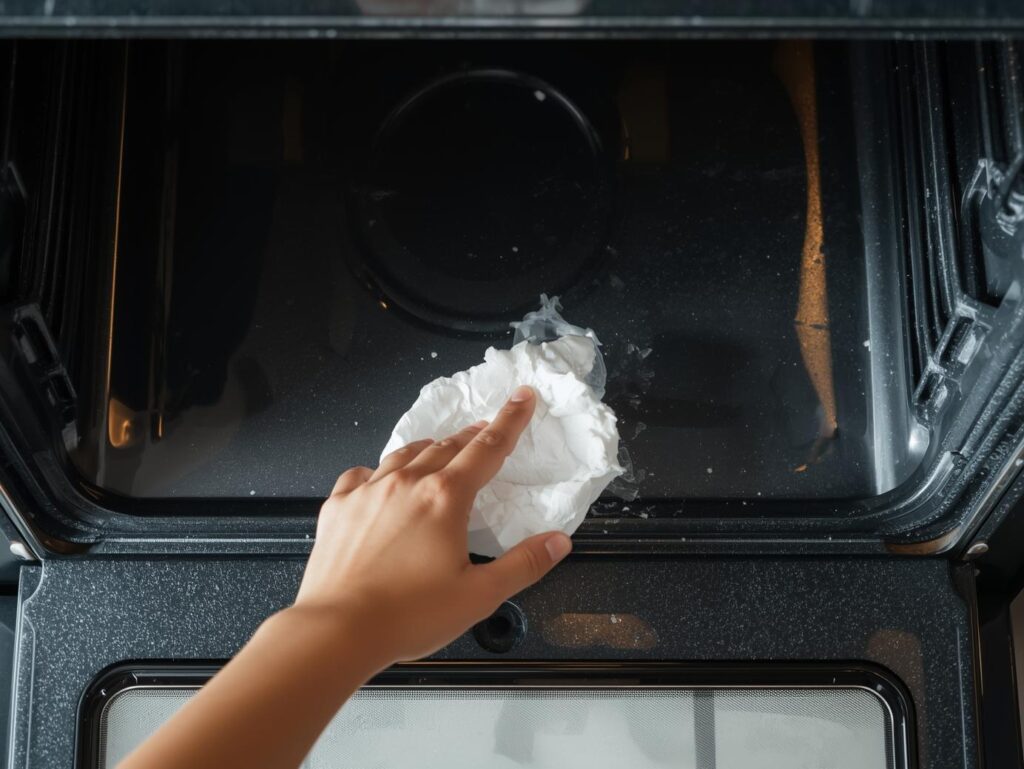Cleaning the oven is one of those chores that everyone dreads.
Grease splatters, burnt-on food, and mysterious stains can make even the most enthusiastic home cook want to avoid opening that oven door.
But a clean oven isn’t just about looks it helps food cook evenly, prevents smoke and odors, and can even extend the life of the appliance.
The good news?
You don’t need harsh chemicals or expensive cleaners to get your oven sparkling.
With a few natural ingredients and some elbow grease, it’s possible to tackle even the toughest messes.
This guide covers everything you need to know about cleaning your oven naturally.
From step-by-step instructions to handy tables and troubleshooting tips, you’ll find everything you need to make oven cleaning a breeze.
Why Clean Your Oven Naturally?
Before diving into the how-to, let’s talk about why natural cleaning methods are worth considering.
|
Reason |
Explanation |
|---|---|
|
Healthier Home |
No harsh fumes or chemical residues that can linger and affect indoor air quality. |
|
Eco-Friendly |
Natural ingredients are biodegradable and safer for the environment. |
|
Cost-Effective |
Most natural cleaners are pantry staples like baking soda and vinegar. |
|
Gentle on Appliances |
Natural methods are less likely to damage oven surfaces or finishes. |

What Makes Ovens So Hard to Clean?
Ovens get dirty for a few reasons:
- Grease splatters from roasting and baking.
- Burnt-on food from spills and drips.
- Sugar and syrup from desserts that caramelize and harden.
- High heat that bakes stains into the surface.
Over time, these messes can build up and become tough to remove. But with the right approach, even the most stubborn grime can be tackled.

Essential Natural Cleaning Ingredients
Here are the top natural ingredients for oven cleaning, along with what they do best:
|
Ingredient |
Best For |
How It Works |
|---|---|---|
|
Baking Soda |
General cleaning, deodorizing |
Mildly abrasive, lifts stains, neutralizes odors |
|
White Vinegar |
Cutting grease, dissolving residue |
Acidic, breaks down grime, reacts with baking soda |
|
Lemon |
Deodorizing, light cleaning |
Natural acid, fresh scent, cuts grease |
|
Salt |
Scrubbing tough spots |
Abrasive, helps lift burnt-on food |
|
Water |
Loosening grime |
Softens baked-on messes |
|
Castile Soap |
Extra cleaning power |
Natural soap, helps dissolve grease |
Tools You’ll Need
- Spray bottle
- Microfiber cloths or old towels
- Non-scratch scrubber or sponge
- Rubber gloves (optional)
- Plastic or silicone spatula
- Small bowl
- Old toothbrush
Step-by-Step: The Natural Oven Cleaning Method
1. Preparation
- Turn off and cool down the oven. Never clean a hot oven.
- Remove oven racks, thermometers, and any loose debris.
- Lay old towels or newspapers under the oven door to catch drips.
2. Make a Baking Soda Paste
- Mix 1/2 cup baking soda with a few tablespoons of water in a bowl.
- Stir until it forms a spreadable paste (like cake frosting).
3. Apply the Paste
- Spread the paste all over the interior surfaces, avoiding heating elements.
- Pay extra attention to greasy or stained areas.
- For tough spots, sprinkle a little salt on top of the paste.
4. Let It Sit
- Let the paste sit for at least 8 hours, or overnight for best results.
- The baking soda will dry and turn brown as it absorbs grease and grime.
5. Wipe Away the Paste
- Use a damp cloth or sponge to wipe away as much of the dried paste as possible.
- For stubborn spots, use a plastic spatula or an old toothbrush.
6. Spray with Vinegar
- Fill a spray bottle with white vinegar.
- Spray the oven interior. The vinegar will react with any leftover baking soda, fizzing and loosening residue.
- Wipe clean with a damp cloth.
7. Final Rinse
- Wipe down all surfaces with a clean, damp cloth to remove any remaining residue.
- Dry with a towel.
Cleaning Oven Racks Naturally
Oven racks can be just as grimy as the oven itself. Here’s a natural way to clean them:
|
Step |
Instructions |
|---|---|
|
1 |
Remove racks and place them in a bathtub or large sink. |
|
2 |
Fill with hot water and add 1/2 cup baking soda and a few squirts of natural dish soap. |
|
3 |
Let soak for 2–4 hours (or overnight for heavy grime). |
|
4 |
Scrub with a non-scratch sponge or brush. |
|
5 |
Rinse and dry thoroughly. |
Natural Cleaning for Oven Glass
The oven door glass often gets cloudy or streaked. Here’s how to clean it naturally:
Baking Soda Paste Method
- Make a paste of baking soda and water.
- Spread on the glass and let sit for 30 minutes.
- Wipe away with a damp cloth.
Lemon Juice Shine
- Cut a lemon in half and rub it over the glass.
- Let sit for 10 minutes, then wipe clean.
Tackling Stubborn Spots
Some stains need a little extra attention. Here are a few natural hacks:
|
Problem |
Solution |
|---|---|
|
Burnt-on sugar or caramel |
Sprinkle with baking soda, spray with vinegar, let fizz, then scrub. |
|
Grease splatters |
Rub with a paste of baking soda and salt, then wipe clean. |
|
Sticky residue |
Apply a little castile soap to a damp sponge and scrub gently. |
Quick Natural Oven Fresheners
After cleaning, keep your oven smelling fresh with these tricks:
- Place a small oven-safe dish of water with lemon slices inside.
- Heat at 200°F (90°C) for 30 minutes.
- Let cool, then wipe away any condensation.
Natural Oven Cleaning Schedule
Keeping a regular cleaning schedule makes deep cleaning easier. Here’s a handy table:
|
Task |
Frequency |
|---|---|
|
Wipe up spills |
After each use |
|
Quick clean with baking soda |
Monthly |
|
Deep clean with baking soda paste |
Every 3–6 months |
|
Clean oven racks |
Every 3–6 months |
|
Clean oven glass |
Monthly |
Natural Oven Cleaning: Do’s and Don’ts
|
Do |
Don’t |
|---|---|
|
Use baking soda and vinegar for most messes |
Use steel wool or metal scrapers (can scratch surfaces) |
|
Let the paste sit overnight for tough stains |
Spray vinegar directly on heating elements |
|
Clean up spills as soon as possible |
Use harsh chemical cleaners if you want to stay natural |
|
Test a small area first if unsure |
Forget to rinse thoroughly—residue can smoke |
Natural Cleaning for Different Oven Types
Not all ovens are the same. Here’s how to adapt natural cleaning methods:
|
Oven Type |
Tips |
|---|---|
|
Self-Cleaning |
Wipe up loose debris first. Use baking soda paste for spots after the cycle. |
|
Convection |
Clean fan cover gently with a damp cloth. Avoid getting paste in vents. |
|
Gas |
Avoid getting paste on gas ports or igniters. |
|
Electric |
Don’t apply paste directly to heating elements. |
Troubleshooting Common Oven Cleaning Problems
|
Problem |
Possible Cause |
Natural Solution |
|---|---|---|
|
White residue after cleaning |
Baking soda not fully wiped away |
Wipe with damp cloth, then dry |
|
Lingering odors |
Old spills or residue |
Heat lemon water in oven, wipe clean |
|
Cloudy oven glass |
Baked-on grease |
Repeat baking soda paste method |
|
Sticky spots |
Sugar or syrup spills |
Baking soda and vinegar fizz, then scrub |
Natural Oven Cleaning for Stubborn Messes
The Steam Method
Steam is a powerful natural cleaner. Here’s how to use it:
- Fill an oven-safe dish with water and a few tablespoons of vinegar or lemon juice.
- Place in the oven and heat to 250°F (120°C) for 30–45 minutes.
- Turn off oven and let cool slightly.
- Wipe down the interior—the steam will have loosened grime.
Salt Scrub for Fresh Spills
If something spills while baking, sprinkle salt over the spill while the oven is still warm (but not hot). Once the oven cools, the salt will have absorbed the mess, making it easy to wipe away.
Natural Oven Cleaner Recipes
All-Purpose Oven Cleaner
- 1/2 cup baking soda
- 1/4 cup white vinegar
- 1 tablespoon salt
- Water to make a paste
Mix ingredients, apply to oven surfaces, let sit, then scrub and wipe clean.
Citrus Degreaser Spray
- 1 cup white vinegar
- Peels from 2 lemons or oranges
- 1 cup water
Combine peels and vinegar in a jar, let sit for a week, then strain and mix with water in a spray bottle. Use for light cleaning and deodorizing.
Frequently Asked Questions
Is it safe to use baking soda and vinegar in my oven?
Yes, both are safe and effective for most oven surfaces. Just avoid getting them on heating elements.
How often should I clean my oven?
A quick wipe after each use and a deep clean every 3–6 months is ideal.
Can I use these methods for toaster ovens?
Absolutely! Just use less paste and avoid getting water near electrical parts.
What if my oven still smells after cleaning?
Try heating a dish of lemon water in the oven, then wipe down the interior.
Natural Oven Cleaning for Busy People
Short on time? Here’s a quick routine:
- Sprinkle baking soda on stains.
- Spray with vinegar.
- Let fizz for 10 minutes.
- Wipe clean with a damp cloth.
This won’t tackle heavy buildup but is great for maintenance.
Oven Cleaning Myths
|
Myth |
Reality |
|---|---|
|
“Natural cleaners don’t work as well as chemicals.” |
With patience and the right method, natural cleaners can be just as effective. |
|
“You need to clean the oven every week.” |
Monthly maintenance and quarterly deep cleans are usually enough. |
|
“Self-cleaning ovens don’t need manual cleaning.” |
They still need spot cleaning and regular wipe-downs. |
Eco-Friendly Oven Cleaning Tips
- Use reusable cloths instead of paper towels.
- Compost lemon peels after use.
- Avoid single-use wipes or disposable sponges.
Final Thoughts
Cleaning your oven naturally doesn’t have to be a dreaded chore.
With simple ingredients like baking soda, vinegar, and lemon, it’s possible to tackle even the toughest messes without harsh chemicals.
The key is patience, letting natural cleaners sit and do their work makes scrubbing easier and more effective.
Regular maintenance, quick cleanups after spills, and a deep clean every few months will keep your oven looking and smelling fresh.
So next time you open the oven and see a mess, skip the chemical sprays and reach for the baking soda.
Your kitchen, your food, and the planet will thank you.










